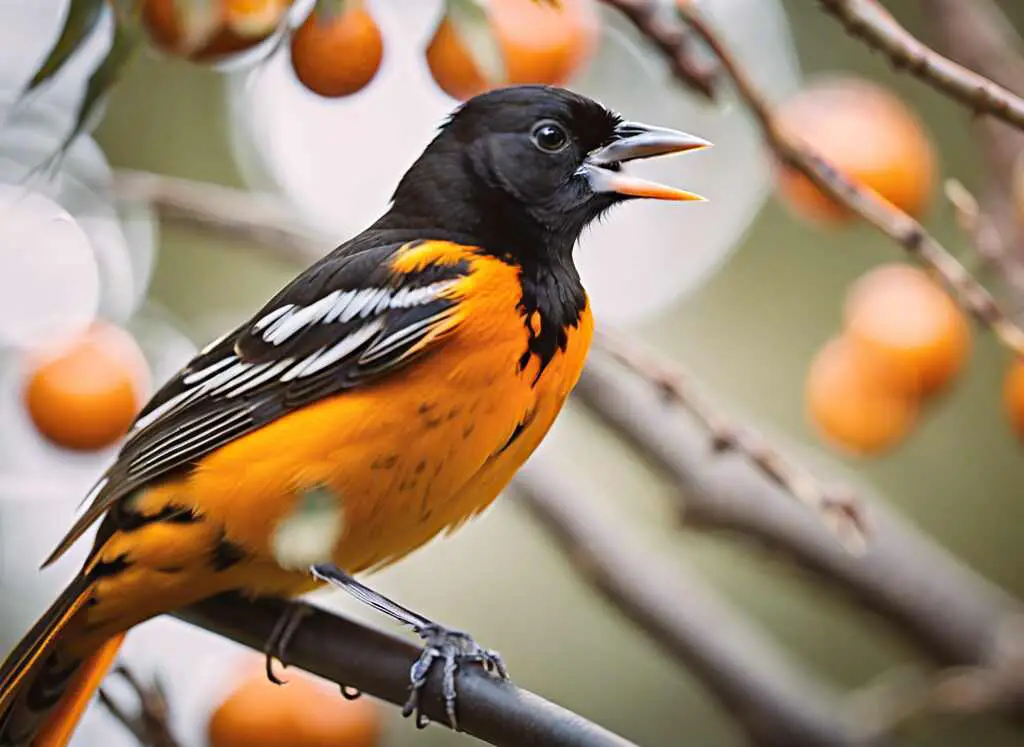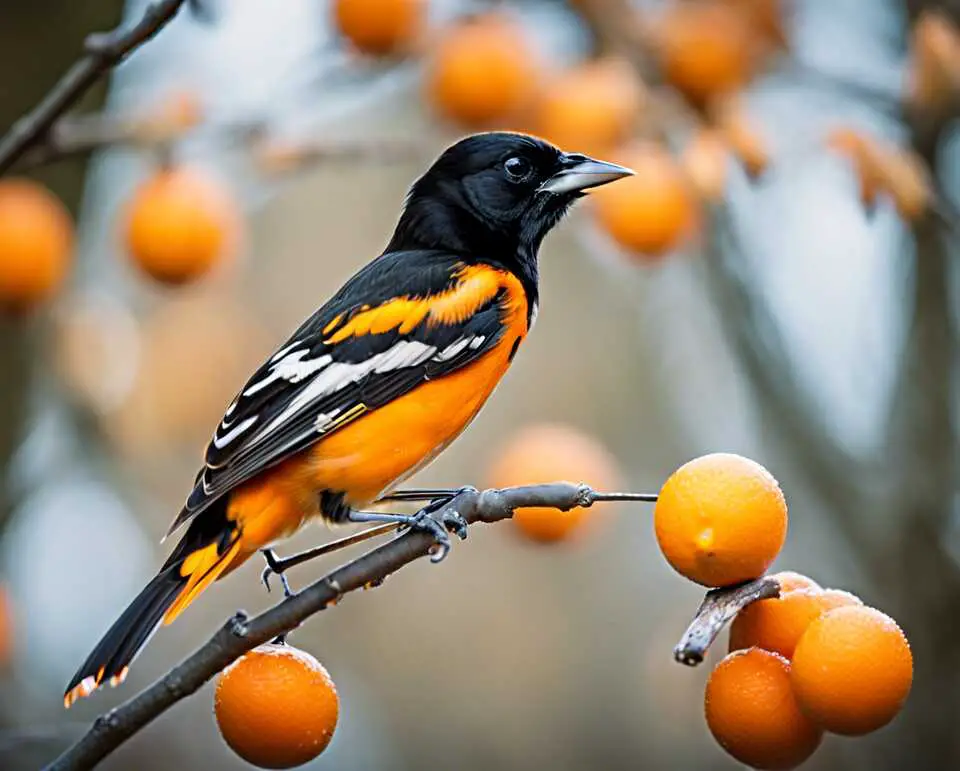Orioles are beautiful songbirds known for their vibrant orange and black plumage. These migratory birds bring a splash of color and melodic songs to backyard environments during the spring and summer months. One of the best ways to attract orioles is by strategically placing oriole feeders in your outdoor space. But where should these feeders be located to optimize your chances of seeing these magnificent birds?
Table of Contents
Key Takeaways:
- Optimal feeder height: Position feeders at least 6 feet off the ground to deter predators.
- Visibility is crucial: Place feeders in open areas, away from dense foliage, for easy bird spotting.
- Consider nearby cover: Ensure there’s vegetation within 10-15 feet for birds to seek refuge.
- Regular maintenance: Clean and refill feeders weekly to keep attracting orioles consistently.
Optimal Placement for Oriole Feeders
The placement of your oriole feeder can greatly impact its effectiveness in attracting these sought-after birds. Here are some tips for finding the ideal spot:
Height Matters
Orioles prefer feeders that are positioned at least 6 feet off the ground. This helps keep the feed out of reach from ground-dwelling predators, such as cats and squirrels. Suspend the feeder from a tree branch or shepherd’s hook to achieve the optimal height.
Visibility is Key
Orioles are drawn to feeders that are easily visible from their natural perches, such as tall trees and power lines. Position the feeder in an open area, away from dense foliage or structures that could obstruct their view. This allows the orioles to spot the feeder from a distance and feel comfortable approaching it.
Proximity to Cover
While visibility is important, orioles also appreciate having nearby cover, such as shrubs or trees. This provides a safe haven for the birds to retreat to if they feel threatened. Aim to place the feeder within 10-15 feet of thick vegetation that can offer protection.
Orientation to the Sun
Orioles tend to be more active in the morning and evening hours when the sun is lower in the sky. Situate your feeder in a location that receives direct sunlight during these prime feeding times. This not only makes it more enticing to the birds but also helps keep the nectar or jelly inside the feeder from spoiling too quickly.
Proximity to Nesting Sites
If you’re lucky enough to have orioles nesting in your yard, position the feeder close to their chosen nesting area, but not directly underneath. This allows the birds to conveniently access the feeder while still maintaining a safe distance from their breeding grounds.
Distance from Other Feeders
Orioles are territorial and may become aggressive towards other orioles at feeding stations. To minimize conflicts, space out any additional oriole feeders in your yard by at least 30-40 feet. This gives each bird its own designated feeding zone.
Choosing the Right Feeder
The type of oriole feeder you select can also impact its appeal to these finicky birds. Opt for feeders with perches that allow the orioles to comfortably grip and feed. Nectar feeders with built-in bee guards and wide openings are preferred, as orioles have long, slender beaks that can struggle with narrow ports.
Jelly and orange feeders are another excellent choice, as orioles have a strong fondness for sweet, fruit-based treats. These feeders should be placed in the shade to prevent the jelly from spoiling too quickly.
Maintaining Your Oriole Feeder
Consistent cleaning and refilling of your oriole feeder is crucial to keeping the birds coming back. Wash the feeder with hot, soapy water at least once a week, and replace any moldy or fermented nectar or jelly. This ensures a fresh, inviting meal for your backyard orioles.
By strategically positioning your oriole feeder and providing high-quality food, you can maximize your chances of attracting these vibrant songbirds to your outdoor space. With a little patience and the right feeder setup, you’ll be rewarded with the magnificent sight and sounds of orioles in your very own backyard.
Considerations for Attracting Orioles to Your Backyard
Choosing the Right Location for Oriole Feeders
Orioles are beautiful and vibrant birds that can bring a wonderful splash of color to any backyard. To attract these feathered friends, it’s important to carefully consider the placement of your oriole feeders. The right location can make all the difference in ensuring a consistent and reliable food source for these beloved birds.
Proximity to Natural Food Sources
Orioles are naturally drawn to sweet nectar and fruit. When choosing a spot for your oriole feeder, look for areas near natural food sources like fruit trees, berry bushes, or even hummingbird feeders. This will make your feeder a more enticing option for the orioles, as it provides a convenient complement to their foraging habits.
Shade and Shelter
Orioles prefer to feed in areas that offer a balance of sun and shade. Placing your feeder in a partially shaded spot, such as near a tree or shrub, can provide the birds with the temperature regulation they need. Additionally, the nearby vegetation can offer valuable shelter and perching spots, making your backyard a more attractive and secure environment for the orioles.
Visibility and Access
Orioles are relatively wary birds, so it’s important to place your feeder in a location that offers good visibility and easy access for the birds. Avoid areas that are too cluttered or obstructed, as this can discourage the orioles from visiting. Instead, choose a spot that is open and unobstructed, allowing the birds to easily see and approach the feeder.
Distance from Other Feeders
While you may be tempted to place your oriole feeder near other bird feeders, it’s generally best to keep them a reasonable distance apart. Orioles can be territorial and may avoid areas where they perceive too much competition for resources. Aim to position your oriole feeder at least 10-15 feet away from other feeders to minimize conflicts and encourage the orioles to feel comfortable visiting.
Accessibility for Maintenance
When selecting the location for your oriole feeder, also consider the ease of access for refilling and cleaning. Choose a spot that is conveniently located and easy to reach, as this will make the maintenance of your feeder a more straightforward task. This will help ensure that the feeder is consistently available and appealing to the orioles.
Protection from Predators
Orioles are vulnerable to predators such as cats, hawks, and other larger birds. Positioning your feeder in an area that offers some degree of protection, such as near dense foliage or a physical barrier, can help keep the orioles safe and encourage them to visit regularly.
By carefully considering these factors, you can create an inviting and secure environment for orioles to visit your backyard. With the right feeder placement, you’ll be well on your way to attracting these beautiful birds and enjoying their vibrant presence throughout the season.
Conclusion
Proper placement of your oriole feeder is crucial for attracting these vibrant birds to your backyard. Factors such as visibility, accessibility, and safety play key roles in creating an inviting environment for orioles. Here are some essential considerations:
- Visibility: Position the feeder in a spot visible from various points in your yard to help orioles locate it easily. Natural perches like trees or shrubs can offer a balance of visibility and cover.
- Accessibility: Opt for locations that are clutter-free and provide a clear flight path to the feeder. Keep the feeder at a height of 5-6 feet and within 10-15 feet of dense cover for an inviting setting.
- Safety: Place the feeder away from high foot traffic, pets, or children’s play areas. Ensure it’s at least 30 feet away from large, reflective windows to prevent collisions.
- Food and Habitat: Offering the right type of food and creating a habitat with native plants can further attract orioles. Providing a consistent food source and maintaining it throughout the season encourages their return.
With thoughtful planning and dedication, you can create a welcoming space that not only attracts these beautiful birds but also enhances the overall health and diversity of your local ecosystem. Enjoy the vibrant presence of these avian visitors in your yard for seasons to come!
Frequently Asked Questions
How high off the ground should an Oriole feeder be?
Many people place their oriole feeder too low for some of these birds to reach it comfortably. It’s best to hang an oriole feeder from at least 8 feet off the ground.
What time of day do Orioles feed?
These birds like to feed early in the morning on insects such as ants, spiders, beetles, caterpillars and flies. Orioles can be spotted eating fruit at nighttime or midday when they roost in trees.
What birds are attracted to Oriole feeders?
There are many types of birds that will be attracted to an Oriole feeder. Northern mockingbirds, summer tanagers, scarlet tanagers, rose-breasted grosbeaks and finches all enjoy the sweet nectar of orioles. Woodpeckers also frequent oriole feeders because they love insects, which is what most other bird feeders provide.
Why do Orioles stop coming to feeders?
Orioles will stop visiting bird feeders once the season changes. Their food choices will change from feeders foods to insects. The time period when they come around varies depending on where you live, but it typically starts in late April and ends in mid-October.
When should I put oranges on my Orioles?
Many people believe that the best time to put oranges on their Orioles is in spring, when the birds are hungry and just coming out of hibernation. But if you’re not an avid birder, there’s no harm in putting oranges on your Orioles year-round.




